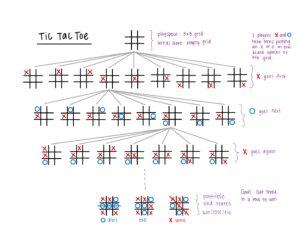- Identify the basic elements in a game of your choice (actions, goals, rules, objects, playspace, players).
The basic elements of the game of Lacrosse are the following:
Actions – Running on the field, cradling the ball (holding the ball inside the net of the stick), passing the ball using the stick, scooping up the ball with the stick, shooting the ball into the net.
Goals – Score the most goals within 60 minutes.
Rules – You cannot touch the ball with anything but the lacrosse stick
(No hands or feet touching the ball). The play stops when the ball goes out of bounds. Offensive players are not allowed to go into the goalie’s circle. Defensive players can run through the circle but cannot stand in the circle. You can hit the stick of an opponent with your stick to make the opponent drop the ball.
Objects – Two nets, Lacrosse Sticks, a rubber game ball.
Playspace – The lacrosse field defined as a rectangular playing area.
Players – Lacrosse players (defense/offense/goalie).
- As a thought experiment, swap one element between two games: a single rule, one action, the goal, or the playspace. For example, what if you applied the playspace of chess to basketball? Imagine how the play experience would change based on this swap.
In soccer, players are not allowed to touch the ball with their hands. Instead, they use their feet, chests, and heads to move the ball around. In basketball, players are only allowed to touch the ball with their hands, dribbling the ball if in motion, or holding it if planning to pass it. If these touching rules were swapped between soccer and basketball, both games would be very different.
In soccer, if players were allowed to touch the ball with their hands, the game would be more like football or rugby where players have to run with the ball in their hands across the field. If they had to dribble the ball, it would be harder to move the ball around or get to the net as fast.
In basketball, if players were not allowed to touch the ball with their hands, it would be way more difficult to get the ball into the high placed net. Players would have to kick the ball high up or use their knees, chests, or heads to get the ball into the high net.
Both games would be very different and difficult to play if these “touching the ball” rules were swapped.
- Pick a simple game you played as a child. Try to map out its space of possibility, taking into account the goals, actions, objects, rules, and playspace as the parameters inside of which you played the game. The map might be a visual flowchart or a drawing trying to show the space of possibility on a single screen or a moment in the game.

- Pick a real-time game and a turn-based game. Observe people playing each. Make a log of all the game states for each game. After you have created the game state logs, review them to see how they show the game’s space of possibility and how the basic elements interact.
Real-Time Game: Clash of Clans
Game Log:
- Player collects gold from mines
- Player collects potions from potion factory
- Player trains troops all of giants
- Player cleans up surrounding areas by using builders to remove bushes and trees
- Player puts builder to upgrade the archery tower
- Etc
In Clash of Clans, players can build their village, with gold mines, troop camps, archery towers, etc. They can go into battle and upgrade their buildings using the gold they mine. The game’s space of possibility is quite large because there are seemingly endless combinations of actions players can take. However, there is still a limited amount of actions that players can take. There are a limited number of types of items that a player can have in their village and attacks have time limits.
Turn-Based Game: Game Pigeon Archery
In Game Pigeon Archery, two players take turns to launch an arrow to a target. Each player gets three tries per turn and each player gets three turns. Players earn points 0-10 per launch depending on where the arrow lands.
Game log:
- Player one (P1) starts first turn
- P1 launches first arrow => lands at 9 points
- P1 launches second arrow => lands at 10 points
- P1 launches third arrow => lands at 7 points
- P1 ends first turn => P1 total score on first turn = 26 points
- Player two (P2) starts first turn
- P2 launches first arrow => lands at 9 points
- P2 launches second arrow => lands at 10 points
- P2 launches third arrow => lands at 9 points
- P2 ends first turn => P2 total score on first turn = 28 points
- P1 takes second turn
- P1 scores 21 points on second turn
- P2 takes second turn
- P2 scores 20 points on second turn
- P1 takes third turn
- P1 scores 20 points on third turn
- P2 takes third turn
- P2 scores 22 points on third turn
- Game Ends
- P1 final score = 67 and P2 final score = 70
- P2 wins game
For game pigeon archery, the game states are the possible combinations of the score locations of the arrows for each player for each try for each turn. The move made by each player is not dependent on the move made by the other player and the target space is not limited after each move. This makes the game’s space of possibility larger than games like tic-tac-toe where a player’s moves are limited by the previous move made by the other player. However, the game’s space of possibility is still smaller than that of the Real-Time game that does not have a time limit or attempt limit.



